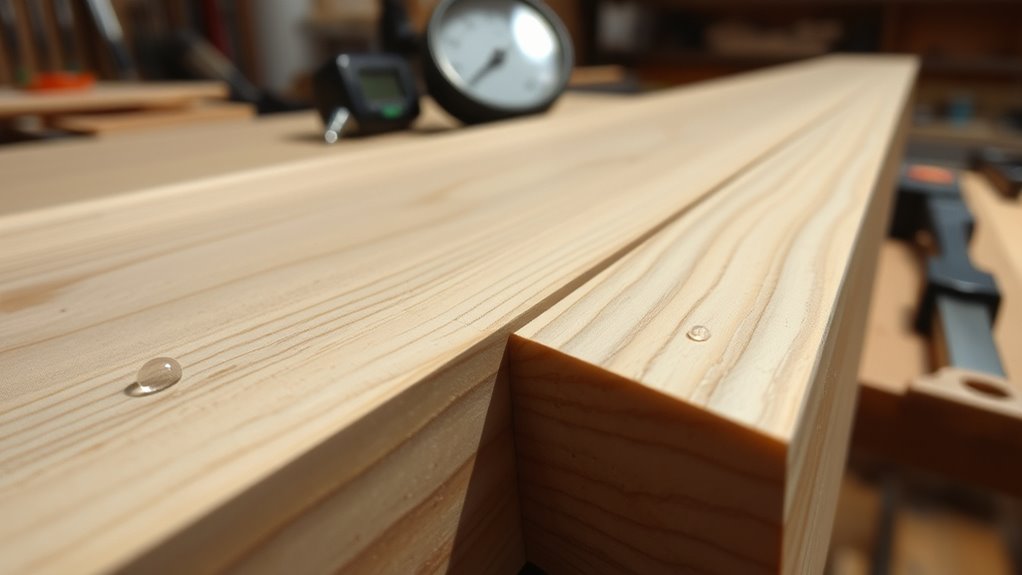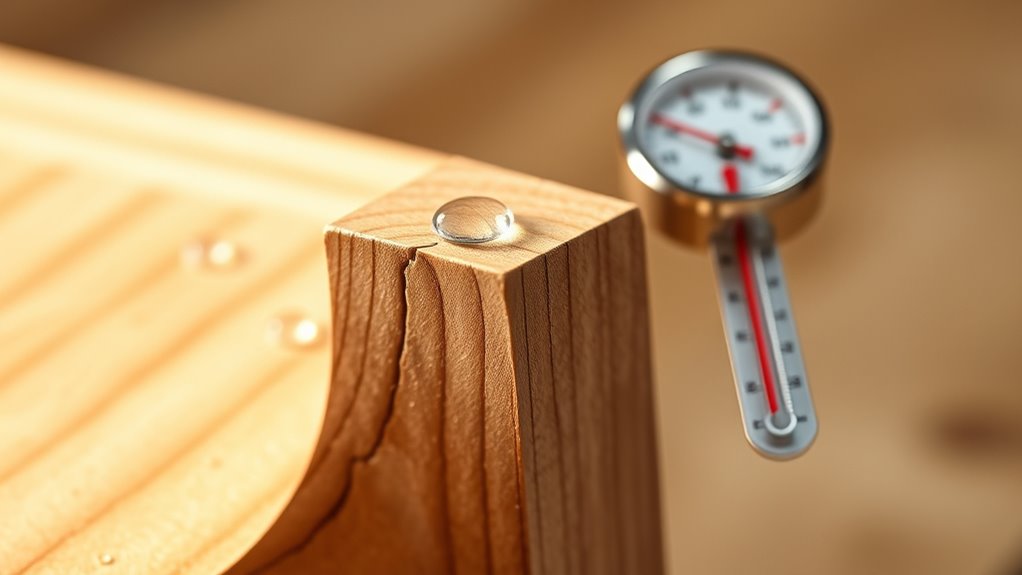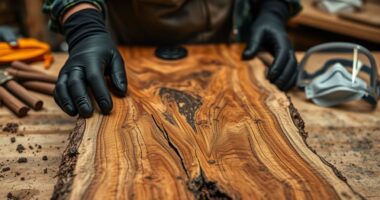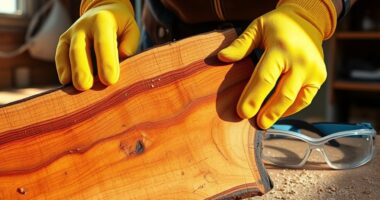To achieve crack-free edge gluing, control your environment’s temperature and humidity. Keep conditions stable to prevent wood from expanding or contracting during bonding and drying. Work in a space with consistent moisture levels and avoid fluctuations that can stress glue joints. Use flexible adhesives and clamp firmly for a tight bond. Managing these factors helps keep your edges crack-free and durable. For more secrets on perfect results, explore the detailed tips ahead.
Key Takeaways
- Maintain consistent temperature and humidity during gluing and drying to minimize wood movement stress.
- Use flexible adhesives like polyurethane or yellow glue to absorb expansion and contraction.
- Schedule gluing projects during stable environmental conditions, avoiding seasons with fluctuations.
- Properly clamp joints to ensure full contact and reduce gaps that can lead to cracks.
- Prepare surfaces thoroughly and follow manufacturer instructions for optimal adhesion and crack prevention.

Achieving crack-free edge gluing is vital for creating strong, durable joints in woodworking projects. When you’re gluing edges, understanding how wood expansion influences the process can make the difference between a seamless bond and a problematic crack. Wood naturally expands and contracts with changes in temperature and humidity, which can cause glued joints to stress and crack if not properly managed. That’s why controlling environmental conditions and selecting the right adhesive are key steps in your woodworking process.
Understanding wood movement is essential for crack-free edge gluing success.
First, consider how wood expansion affects your glue joints. During high humidity or when temperatures rise, wood fibers swell, putting strain on the glue joint. Conversely, in dry or cooler conditions, wood shrinks, which can lead to gaps or cracks along the edges. If you don’t account for these movements, even the strongest adhesive may fail over time. To prevent this, you need to understand your working environment and aim for stable conditions during gluing and drying. Ideally, work in a location with consistent temperature and humidity levels, or schedule your project during seasons when environmental fluctuations are minimal. This reduces stress on the joint caused by wood expansion and contraction.
Next, the choice of adhesive plays a pivotal role in achieving crack-free edges. Not all glues are created equal; some are more flexible and accommodating of wood’s natural movements. Polyurethane and yellow woodworking glues tend to have some flexibility, which helps absorb the stresses caused by expansion and contraction. These adhesives are more forgiving when wood shifts, reducing the risk of cracks forming along the joint. On the other hand, rigid glues like epoxy or PVA might provide very strong bonds but are less tolerant of movement. If you opt for a more rigid adhesive, it’s even more important to ensure that environmental conditions are stable and that the wood is properly prepared beforehand. Additionally, selecting appropriate adhesives that match your project’s needs and environmental conditions can significantly improve your results. Proper adhesive selection isn’t just about choosing the strongest glue; it’s about matching the glue’s properties to your project’s needs. For instance, if you’re working on outdoor furniture or in a humid climate, a waterproof adhesive that remains somewhat flexible will give you better results. Additionally, always follow the manufacturer’s instructions regarding application and drying times. Applying the right amount of glue and clamping the pieces firmly during curing helps ensure the joint remains tight and minimizes the chances of cracks developing later.
Frequently Asked Questions
What Are the Best Tools for Precise Edge Gluing?
You need the right tools for precise edge gluing, so start with high-quality glue application tools like fine-tipped brushes or squeeze bottles to control glue flow. Use clamping techniques such as bar clamps or corner clamps to hold edges firmly in place. These tools make certain of even pressure and accurate alignment, preventing gaps and cracks. Combining the right glue application tools with effective clamps guarantees a professional, crack-free finish every time.
How Do Different Wood Species Affect Glue Adhesion?
You might think all wood species bond equally, but in reality, wood type impacts glue compatibility. Hardwoods like oak or maple offer a dense surface, enhancing adhesion, while softwoods like pine can be more porous, requiring different glue types. Understanding how different wood species affect glue adhesion helps you choose the right adhesive, ensuring a strong, crack-free bond. Always test compatibility before starting your project for the best results.
Can Climate Control Prevent Edge Gluing Failures?
Climate control plays a vital role in preventing edge gluing failures. By maintaining consistent temperature and humidity levels, you reduce the risk of glue failures caused by wood expansion or contraction. Proper climate control guarantees the wood’s moisture content stays stable, allowing the glue to bond effectively. This way, you can avoid cracks and weak joints, achieving stronger, longer-lasting edges without worrying about environmental fluctuations sabotaging your project.
Are There Eco-Friendly Adhesives Suitable for Edge Gluing?
Did you know that the global demand for eco-friendly adhesives has grown 20% annually? You can choose eco-friendly adhesives for sustainable gluing, which reduces harmful chemical emissions and environmental impact. These adhesives are suitable for edge gluing, offering strong bonds without compromising your eco-conscious values. By selecting sustainable gluing options, you help protect the environment while achieving high-quality results in your woodworking projects.
How Long Should I Wait Before Handling Glued Edges?
You should wait at least 24 hours before handling glued edges, as this allows the drying time and curing duration to fully set. Rushing the process can cause gaps or weak bonds. Keep the edges undisturbed during this period to guarantee the adhesive bonds properly. For ideal results, check the manufacturer’s instructions, as some eco-friendly adhesives may require slightly longer curing times for a strong, crack-free finish.
Conclusion
By mastering the secrets of temperature and humidity, you hold the key to crack-free edge gluing. Think of your workshop as a delicate dance floor—balancing these factors keeps your project in perfect harmony. When you control the environment, cracks become nothing but distant memories, and your craftsmanship shines through. Remember, a well-tuned space isn’t just a setting; it’s the silent partner in every flawless glue-up you create.









